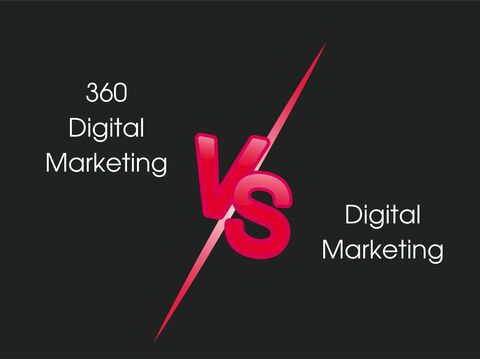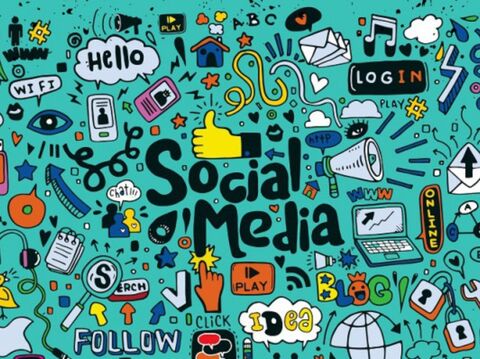360 Digital Marketing vs Digital Marketing: Understanding the Critical Differences

The digital marketing space is fragmented. Brands now face a choice: run disconnected campaigns across multiple channels, or orchestrate a unified customer experience that follows prospects everywhere they go.
This choice defines the difference between traditional digital marketing and 360 digital marketing.
Most businesses still operate with siloed teams managing separate channels - SEO specialists optimising search, social media managers posting content, email marketers sending campaigns. Each channel performs independently, creating inconsistent messaging and lost opportunities.
360 digital marketing eliminates these silos. It synchronises every touchpoint into one integrated strategy.
The result is that customers encounter consistent brand messaging across all platforms, which dramatically improves conversion rates and customer lifetime value. Let’s compare 360 digital marketing vs. digital marketing.
What is 360 Digital Marketing?
A 360 marketing strategy ties all traditional and digital marketing elements together to create a perfectly crafted experience for the audience. It's like a choose-your-own-adventure book, but instead of a book, it's your customer's journey, and they can enjoy it on any device or platform they like.
Imagine seeing an ad for a burger from a well-known brand on a billboard while driving to work. Then on your lunch break, you see the same ad on your Instagram account. And when you get home and swipe through YouTube videos, you watch the same burger ad on YouTube. It's like a full-course meal of marketing!
That's why GrowthJockey recommends adopting 360 digital marketing along with other different types of marketing.
Quick comparison: 360 digital marketing vs. digital marketing
| Aspect | 360 digital marketing | Traditional digital marketing |
|---|---|---|
| Strategic Approach | Integrated, holistic strategy connecting all channels into one cohesive customer experience. | Standalone, channel-specific tactics. Each channel operates independently with separate objectives and limited cross-channel coordination. |
| Channel Coverage | Utilises all relevant digital channels - SEO, PPC, social media, email, content marketing, display ads, video, and offline touchpoints. | Focuses on one or a few specific channels. Typically SEO-only, PPC-only, or social-only approaches with minimal integration. |
| Customer Journey View | Complete 360-degree view of the customer journey across all touchpoints. | Limited visibility into the customer journey. |
| Messaging Consistency | Identical brand messaging, tone, and value proposition across every platform. | Inconsistent messaging across channels. |
| Data Integration | Centralized data infrastructure combining insights from all channels. | Siloed data trapped in separate platforms. |
| ROI Measurement | Understands how channels work together to drive conversions and calculates true customer acquisition cost. | Difficult to calculate overall marketing effectiveness or understand which touchpoints actually drive conversions. |
| Campaign Planning | Long-term strategic planning required. | Quick tactical deployment. |
| Time to Market | Slower initial deployment. | Faster deployment. |
| Best Suited For | Mid-to-large businesses, established brands, companies with complex customer journeys. | Small businesses, startups with limited resources. |
360 Digital Marketing vs. Digital Marketing: What's the difference?
360 Digital Marketing:
1. Integrated Approach:
- Covers all digital marketing aspects, ensuring all channels work together to achieve overall marketing goals.
- Includes SEO, PPC, social media, email, and content marketing.
- Provides a comprehensive view of the customer journey and their interactions with the brand.
2. Utilizes All Digital Channels:
- Engages customers through multiple channels, ensuring different tactics work together.
- Offers a holistic view of the customer journey across different touchpoints.
3. Optimizes Opportunities:
- Provides a full analysis of the digital marketing strategy and its effectiveness.
- Allows continuous optimization to achieve desired results.
4. Focuses on the Entire Customer Journey:
- Ensures all channels and tactics work together to achieve overall marketing goals.
- Delivers a seamless and cohesive customer experience.
5. Ensures Measurable ROI:
- Utilizes data to measure KPIs such as website analytics, customer surveys, and social media metrics.
- Integrates offline elements to create tailored and effective marketing campaigns.
6. Cost-Effective
- Offers a comprehensive approach to optimize all aspects of the digital marketing strategy, suited for SMBs and startups.
Digital Marketing:
1. Standalone Approach:
- Focuses on one or a few specific areas of digital marketing, such as SEO or PPC.
- Lacks integration and visibility into the customer journey across different channels.
2. Utilizes One or Two Digital Channels:
- May result in a lack of reach and visibility for the brand.
- Limited understanding of the customer journey across different channels.
3. Limited Optimization:
- Focuses on individual tactics or campaigns rather than the overall strategy.
- Lack of understanding of the effectiveness of the overall strategy and how it can be improved.
4. Focuses on Select Parts of the Customer Journey:
- May not consider how tactics work together in the overall strategy.
- Limited optimization to achieve overall marketing goals.
- Challenges in Measuring ROI:
- Calculating holistic ROI is challenging due to the standalone nature of tactics.
- Difficult to get a clear idea about overall ROI.
6. Potentially More Expensive:
- Higher costs due to repeated or improved specific tactics or campaigns separately.
- Suitable for big enterprises rather than SMBs or startups.
Challenges of 360 digital marketing
While 360 digital marketing delivers superior results, implementing this integrated approach presents several real-world obstacles that businesses must navigate carefully.
Requires significant cross-team coordination
Breaking down departmental silos is easier said than done. Your SEO team, paid media specialists, content creators, and offline marketing managers have spent years operating independently.
Suddenly asking them to synchronise campaigns, share data, and align messaging requires a fundamental shift in organizational culture.
Higher upfront planning investment
Traditional marketing lets you launch quickly. Pick a channel, create content, deploy. Done.
360 marketing demands comprehensive planning before a single ad runs. You must map complete customer journeys, identify every touchpoint, establish brand guidelines across channels, and create content variations for multiple platforms - all before launch.
Technology integration complexity
Your email platform doesn't talk to your CRM. Your social media scheduler operates separately from your analytics tool. Your offline event data lives in spreadsheets.
360 marketing exposes these disconnected systems immediately. Integrating technology stacks, or replacing them entirely, requires technical expertise, significant budget, and inevitable migration headaches. Many businesses underestimate both the cost and disruption this creates.
Demands unified data infrastructure
Effective 360 marketing depends on seeing the complete customer journey. That requires centralising data from every channel - website analytics, ad platforms, CRM, point-of-sale systems, customer service interactions.
Building this unified data infrastructure is expensive and time-consuming. Even after implementation, maintaining data quality, ensuring privacy compliance, and training teams to use centralised systems creates ongoing operational overhead.
Risk of message fatigue
When customers encounter your brand across every channel - social media, email, display ads, search, offline - there's a fine line between consistent presence and overwhelming repetition.
Poor execution leads to message fatigue, where prospects actively avoid your brand because they feel bombarded.
Wrapping Up
360 Digital marketing is rapidly gaining attraction as businesses are increasingly taking a holistic approach to their growth. At GrowthJockey, we assist businesses in taking-on the modern business problems.
If you, too, are running a business or managing a marketing department, you can use 360 digital marketing to craft effective strategies that deliver results.
We are just a call away if you want more information on 360 digital marketing or need help strategizing. Feel free to reach out; we can surely develop some helpful solutions.
At GrowthJockey - Full Stack Venture Builder, our unwavering dedication lies in providing comprehensive solutions for 360 digital marketing that effectively tackle the crucial challenges confronted by our clients across diverse industries. Regardless of the size of your company, whether a small-scale enterprise or a large corporation, you can now leverage the advantages of our cutting-edge digital marketing strategies.
Get in touch with us and unlock the next level of growth for your brand. Our team of experts is ready to help you achieve remarkable results in the digital landscape.
FAQs
1. What is 360 Digital Marketing?
360 Digital Marketing is a comprehensive strategy that integrates all digital channels (SEO, PPC, social media, email, and content marketing) to create a cohesive customer journey.
2. How does 360 Digital Marketing differ from traditional Digital Marketing?
Unlike traditional digital marketing, which often focuses on individual channels, 360 Digital Marketing ensures all channels work together, providing a seamless and optimized customer experience.
3. Is 360 Digital Marketing suitable for small businesses?
Yes, 360 Digital Marketing is highly suitable for small businesses as it offers a cost-efficient and comprehensive approach to reach and engage customers across multiple channels.
4. What is DV360 in digital marketing?
DV360 (Display & Video 360) is Google's enterprise-level demand-side platform (DSP) for programmatic advertising. It enables marketers to plan, buy, measure, and optimise digital ad campaigns.
5. What is a 360 marketing role?
A 360 marketing role requires managing integrated campaigns across all customer touchpoints - both digital and traditional. 360 marketing professionals must understand how each touchpoint influences the others and optimize the complete customer experience.








